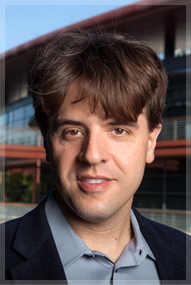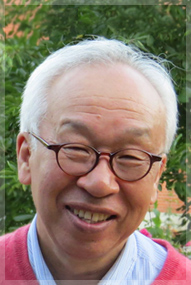The 2014 Keio Medical Science Prize Awardees
Karl Deisseroth, M.D., Ph.D.

D.H. Chen Professor of Bioengineering and of Psychiatry and Behavioral Sciences
Investigator, Howard Hughes Medical Institute, Stanford University
Reason for Selection
The Realization of Optogenetics and Elucidation of Brain Function at the neuronal network level
Dr. Karl Deisseroth achieved control of neuronal activity with high temporal and cellular precision through a combination of microbial opsin expression and illumination. This innovative technology, termed optogenetics, has enabled us to address the causal relationship between neuronal circuits and behavior. Thus, Dr. Deisseroth first provided "a method by which all neurons of just one type could be activated or inactivated, leaving the others more or less unaltered" (Francis Crick, 1979), which had been a long-required task in the field of neuroscience. Dr. Deisseroth clarified many unresolved questions, such as the neuronal circuits responsible for anxiety- and depression-like behaviors. Optogenetics has further permitted us to control intracellular signals such as calcium and cAMP signals, and thus it can be widely applied to biomedical and life science research. By making optogenetics a reality and leading this new field, Dr. Deisseroth has made enormous contributions towards the fundamental understanding of brain functions in health and disease.
Background
- 1988-1992
- A.B., Biochemical Sciences, summa cum laude,
Harvard University - 1992-2000
- M.D., Stanford University Medical School (MSTP Program)
- 1994-1998
- Ph.D., Stanford University (Neuroscience)
- 2004-present
- Principal Investigator and Laboratory Head,
Department of Psychiatry and Behavioral Sciences,
Stanford University Clark Center - 2005-2008
- Assistant Professor of Bioengineering and of Psychiatry and
Behavioral Sciences, Stanford University - 2009-2012
- Associate Professor of Bioengineering and of Psychiatry and
Behavioral Sciences, Stanford University - 2012-present
- Professor of Bioengineering and of Psychiatry and
Behavioral Sciences, Stanford University - 2012-present
- D.H. Chen Professor, Stanford University
- 2013/4-present
- Investigator, Howard Hughes Medical Institute
- 2013-present
- Foreign Adjunct Professor, Karolinska Institutet, Stockholm
Comments
It is a tremendous honor to receive the 2014 Keio Medical Science Prize, in recognition of our efforts to develop optogenetics, and to apply this technology to deepen the understanding of the brain in health and disease. This Prize is particularly meaningful because optogenetics originated as a tool to study the basic science of biology, not medical illness, and yet is enabling discovery of insights into disease states, as well as into healthy brain function. From both the neuroscience and psychiatry perspectives, I hope that this story helps further encourage and strengthen fundamental biology research.
Hiroshi Hamada, M.D., Ph.D.

Professor, Graduate School of Frontier Biosciences, Osaka University
Reason for Selection
Molecular and Cellular Mechanisms of Left-Right Asymmetry
Establishment of body axes is central to the organization of the vertebrate body plan. However, the molecular basis of left-right (L-R) asymmetry remained totally unknown until recently. In 1996, Dr. Hiroshi Hamada discovered the gene called Lefty that is expressed L-R asymmetrically in the mouse embryo, and this discovery served as a breakthrough that made subsequent studies possible. By employing genetic approaches, he has studied the role and regulation of two central signaling molecules (Lefty and Nodal), has identified other components essential for L-R asymmetry, and has dissected the genetic pathway that establishes L-R asymmetry in the mouse embryo. More recently, he has studied the mechanism of L-R symmetry breaking. Dr. Hiroshi Hamada's continuous contribution to the field of developmental biology makes him well deserving of the Keio Medical Science prize.
Background
<Education>
- 1969-1975
- Medical School, Okayama University (M.D.)
- 1975-1979
- Graduate School, Okayama University (Ph.D.)
<Academic Carrier>
- 1979
- Visiting Researcher, Cancer Institute (Tokyo, Japan)
- 1979-1984
- Visiting Associate/Visiting Scientist, National Cancer Institute, NIH (Bethesda, USA)
(Supervisor: Dr. Takeo Kakunaga, Subject: Malignant Transformation) - 1985-1988
- Assistant ProfessAssistant Professor, Faculty of Medicine,
Memorial University of Newfoundland, (St. John's, Canada)or - 1988-1993
- Associate Professor, Department of Biochemistry, Faculty of Medicine, University of Tokyo
- 1993-1995
- Chief, Division of Developmental Biology & Cancer Prevention, Tokyo Metropolitan Institute for Medical Sciences (Tokyo, Japan)
- 1995-2002
- Professor, Institute for Molecular & Cellular Biology, Osaka University
- 2002-present
- Professor, Graduate School of Frontier Biosciences, Osaka University
Comments
I am grateful to the selection committee for awarding me Keio Medical Science Prize, by which I was greatly honored. This award recognizes our 20 years' efforts to understand how morphological asymmetries develop in the mouse embryo. I have been fortunate to share a number of exciting findings with many talented colleagues in Tokyo Metropolitan Institute of Medical Science and Osaka University. Also collaborations with many scientists all over the world were essential. My thanks go to those colleagues and collaborators.
